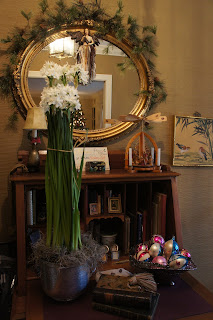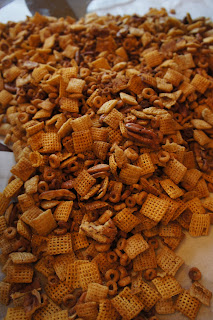The Snipes family takes our Christmas surprises quite seriously. We can hold onto them for months and refuse any persuasion to know what a gift may be. Yet, the one thing that remains not a surprise is our Christmas dinner... a steady constant for about the past decade. It was chosen based on tradition and of course it is Christmas colors. The base is a chicken dish brought from my mom's Georgie recipe repertoire, Country Captain (red sauce), a form of a Southern green bean (green), and of course our traditional congealed salads (one red, and one green). Having grown up, forcefully learning to savor congealed salads every Christmas, I never thought of them as such a novelty. Until my friend Emily Ballard and I spent a ride to the beach this past Easter discussing them or rather making fun of them. I must admit, I feeling a bit ashamed, I did not bring up our two salads that frequent our dining room table every 25 of December.
While I was melting cream cheese into strained pineapple juice (yes. you can melt cream cheese) for our "Christmas Salad" (so appropriately named due to the greens & reds that create this one). I began to think of the role these classic sides play to our palettes. As Southerners, we are known and respected around the world for our fried chicken, biscuits, vegetables laden with butter, and other delicacies, but no one seems to take note of the congealed salad. They are the staple to potlucks, holiday dinners, and plate lunches all throughout the southeast. They come in a rainbow of colors with a rainbow of ingredient combinations floating in a tasty congealed state. The beauty of a congealed salad is that there is a color and an ingredient for every occasion. Just this past thanksgiving at a church potluck, we experienced an orange one that had the same hues of the plates for which we were eating upon. This spiked a controversy in the congregation because traditionally the congealed salad was...red.
For this particular article, I had to look up how to even spell the word congeal and came across this dictionary.com result. I must admit that the third definition nails it..." to make or become fixed, as ideas, sentiments, or principles"... because it is a absolute Southern staple.
con·geal
[kuh n-jeel]
n-jeel]
verb (used with object), verb (used without object)
1.to change from a soft or fluid state to a rigid or solid state, as by cooling or freezing:
The fat congealed on the top of the soup.
2. to curdle; coagulate, as a fluid.
3. to make or become fixed, as ideas, sentiments, or principles: Some philosophic systems lost their vitality and congealed.
Tomato aspic. Along with our sweet "Christmas" salad (its basis of lime jello with chopped cherries, pecans, and pineapple), we also include one of the savory nature to the menu, aspic. Another Georgie staple from my mom' s lineage. My dad always says that "you don't grow to like aspic...you marry into it". Last year while sitting at the Christmas dinner table, I ever so politely suggested an alternative to our beloved tomato aspic. For those of you that aren't familiar, aspic is of the savory congealed salads. It consists of tomato juice, onions, olives, celery, and hot sauce. As a lover of "Zing Zang's" bloody mary mix, I suggested we try it as a replacement for the boring tomato juice. My suggestion was so convincing (or persistent) that the Pegs insisted I make it this year for a taste off...the entire time insisting that my grandmother, had she been alive, would have never approved of such a replacement.
Not knowing that she makes it from a recipe in her head, I took off full force slicing and dicing and mixing gelatin. 2 minutes later my ignorance of the science of gelatin was brought to fruition. I had assumed it was a throw it all together recipe..not a boil, cold water, and wait type recipe....I immediately regretted my egotistical attempt to improve upon this Christmas staple.
 Most of you know that I am a quite competent cook, but realized in minutes I was in over my head. Soon, I had to strain all of my ingredients from the Zing Zang's because aspic like most other congealed sensations is a delicate, balanced process...that must be taken seriously. I mean, these ladies in the 50's were obviously not of the fast food generation...
Most of you know that I am a quite competent cook, but realized in minutes I was in over my head. Soon, I had to strain all of my ingredients from the Zing Zang's because aspic like most other congealed sensations is a delicate, balanced process...that must be taken seriously. I mean, these ladies in the 50's were obviously not of the fast food generation... In the process of straining my concoction, my gelatin mixture congealed too fast....
Causing Beau to become very concerned with the fact that the words coming from my mouth were not of Christmas cheer...
 And what seemed like three hours later, I began to question whether I had even grown up in below the Mason Dixon line? But after some miraculous culinary artwork and moving past the desire to pour vodka into the concoction for a bloody mary, I managed to save my rendition of tomato aspic...
And what seemed like three hours later, I began to question whether I had even grown up in below the Mason Dixon line? But after some miraculous culinary artwork and moving past the desire to pour vodka into the concoction for a bloody mary, I managed to save my rendition of tomato aspic... and in a Bobby Flay throw down style...took home the winning aspic for this Christmas dinner.
I leave the final posting of this year with images from a Delta Christmas. I hope you all have a wonderful Christmas night and enjoy your time with families and loved ones. May your new year be gold, your bourbon bold, and those congealed salads cold!
















































